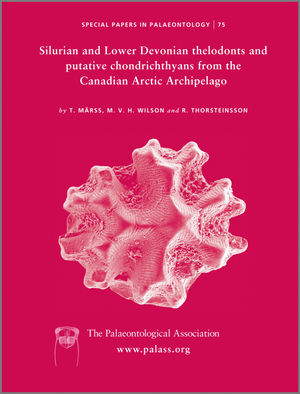Reg. Charity No. 1168330

Thelodonts and putative chondrichthyans from rocks of upper Llandovery (Lower Silurian) to Lochkovian (Lower Devonian), mainly from Baillie-Hamilton and Cornwallis islands, Arctic Canada, are treated according to taxonomic content, spatio-temporal distribution, and possible significance for recognition of geological event levels. The systematics of numerous groups of thelodonts can, for the first time, be based on both articulated specimens and isolated scales. Some 39 thelodont species (12 of them preserved as articulated squamations) belonging to 25 genera, 16 families, and five orders, together with two putative chondrichthyan taxa (both represented by articulated squamations) are treated. The thelodont order Loganelliiformes Turner, contains herein the family Loganelliidae Karatajūté-Talimaa, with the genera Loganellia Turner, represented by L. scotica (Traquair), L. sulcata Märss et al., L. prolata Märss et al., L. grossi Fredholm, and L. exilis Märss et al., and Illoganellia Märss et al., including I. colossea Märss et al., and the family Nunavutiidae Märss et al., with the genus Nunavutia Märss et al., comprising N. fasciata Märss et al.
The order Shieliiformes Märss et al. includes the family Shieliidae Märss et al., with the genus Shielia Märss, represented by S. parca Märss et al. and S. gibba Märss et al., along with the genus Paralogania Karatajūté-Talimaa, incorporating P. martinssoni (Gross) and P. readbayensis Märss et al.
The order Phlebolepidiformes Berg comprises the family Phlebolepididae Berg, with the genus Erepsilepis Märss et al. with its species E. margaritifera Märss et al., and the family Katoporodidae Märss et al., with the genera Katoporodus Turner and Peel, represented by K. tricavus (Gross), K. serratus Märss et al., and K. gemellus Märss et al., Overia Soehn et al., containing O. adraini Soehn et al., and Goniporus Gross, characterized by G. alatus (Gross).
The order Thelodontiformes Kiaer includes the family Coelolepididae Pander, with the genus Thelodus Agassiz, represented by T. inauditus Märss et al. and Thelodus? sp. indet. The family Lanarkiidae Obruchev contains the genera Lanarkia Traquair, exemplified by L. horrida Traquair and Lanarkia? sp., and Phillipsilepis Märss et al., characterized by P. crassa Märss et al., P. cornuta Märss et al., and P. pusilla Märss et al. The family Archipelepididae Märss, in Soehn et al., has one genus, Archipelepis Märss (in Soehn et al.), with one species, A. bifurcata Märss et al. The family Boothialepididae Märsscontains the genus Boothialepis Märss, represented by B. thorsteinssoni Märss. The family Turiniidae Obruchev comprises the genus Turinia Traquair with the species T. polita Karatajūté-Talimaa. The family Nikoliviidae Karatajūté-Talimaa includes the genera Nikolivia Karatajūté-Talimaa, represented by N. gutta Karatajūté-Talimaa and N. auriculata Märss et al., and Chattertonodus Märss et al., represented by C. cometoides Märss et al. The family Talivaliidae Märss et al. embraces the genera Talivalia Märss et al., represented by T. elongata (Karatajūté-Talimaa), and Glacialepis Märss et al. with G. corpulenta Märss et al.
Questionably assigned to the order Thelodontiformes is the family Eestilepididae Märss et al., with one genus, Eestilepis Märss et al., represented by E. prominens Märss et al.
The order Furcacaudiformes Wilson and Caldwell, occurs in the sections studied as the family Furcacaudidae Wilson and Caldwell, with the genus Canonia Vieth comprising three species: C. grossi Vieth, C. costulata Märss et al. and Canonia? sp.
Questionably assigned to the order Furcacaudiformes is the family Barlowodidae Märss et al., with the genera Barlowodus Märss et al., containing B. excelsus Märss et al., B. floralis Märss et al., and B. tridens Märss et al., and Sophialepis Märss et al., represented by S. ancorata Märss et al.
Taxa of putative chondrichthyans of uncertain ordinal position comprise the family Kannathalepididae Märss and Gagnier, with the genus Frigorilepis Märss et al., including F. caldwelli Märss et al., along with the family Wellingtonellidae Märss et al., with the genus Wellingtonella Märss et al., represented by W. gagnieri Märss et al.
Both taxonomic and morphological diversity of thelodonts is much greater than previously known; new anatomical information will allow greater precision in future phylogenetic studies of thelodonts and related vertebrates. Biostratigraphic distribution of taxa allows improved correlation of strata between Europe, the Canadian Arctic islands, and the Mackenzie Mountains, and greater precision in identification of the Llandovery ⁄ Wenlock boundary and the associated carbon-isotope excursion event.